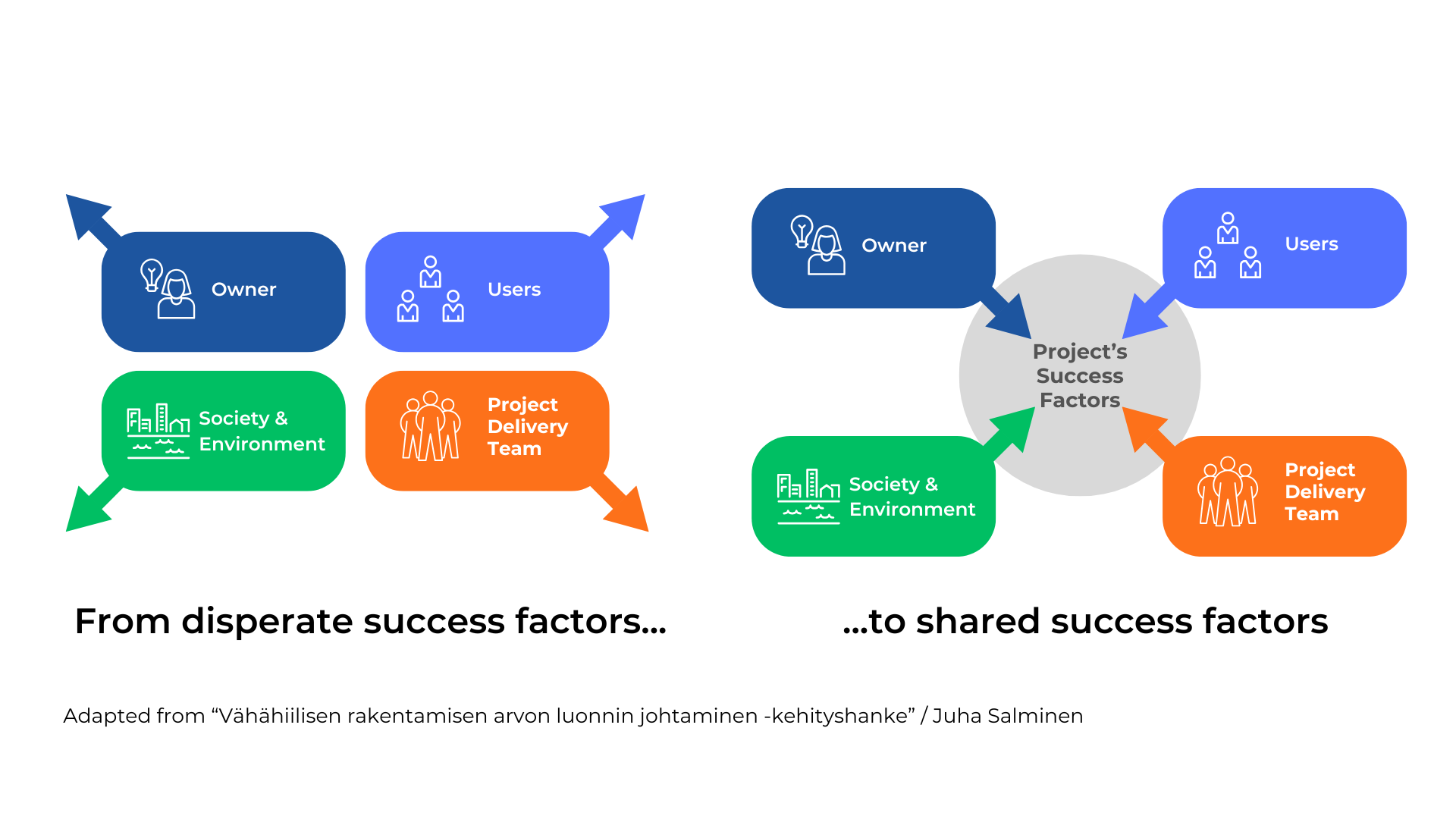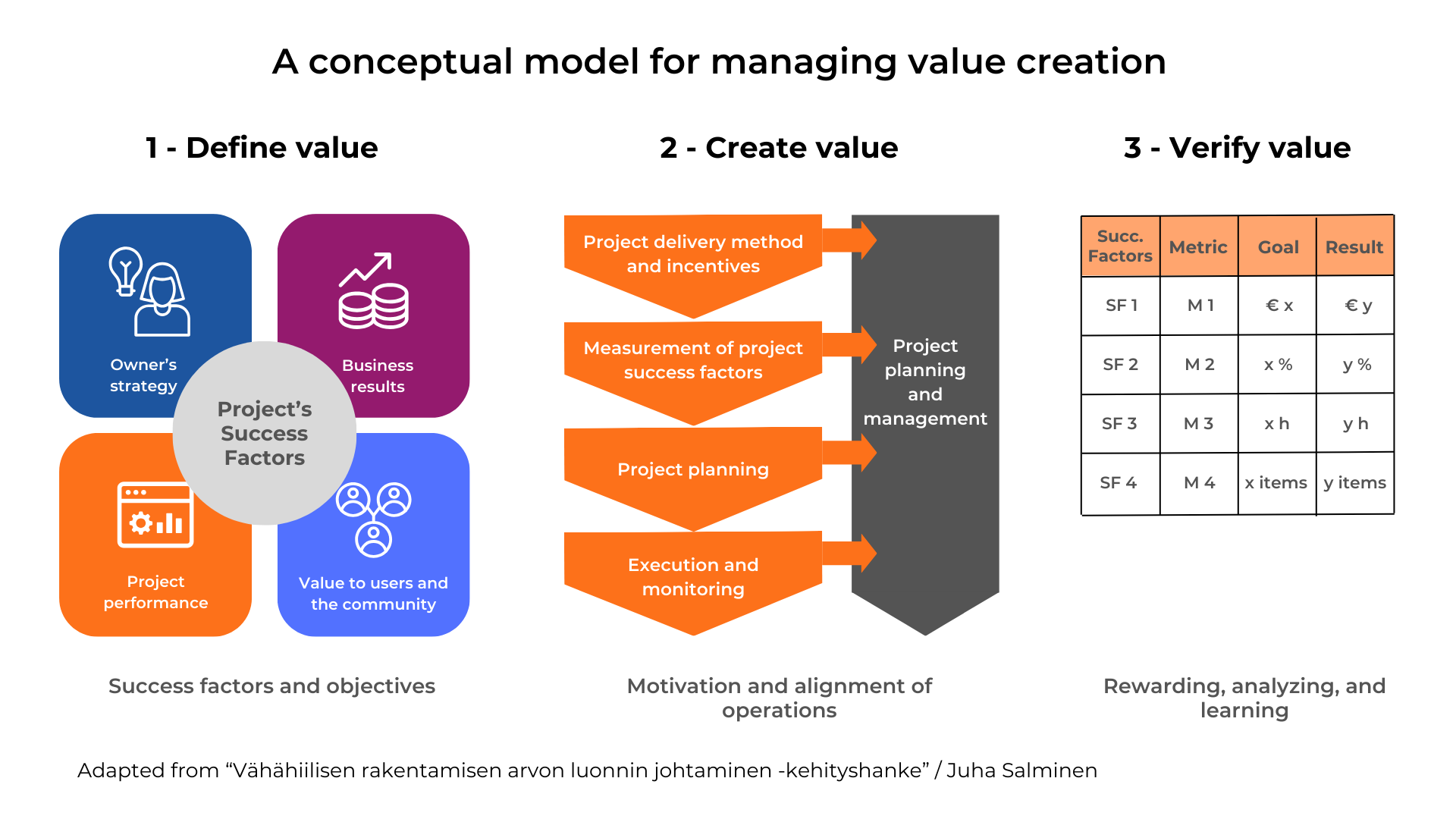“People come together on AEC projects as strangers. Too often leave as enemies.” That’s a quote from Sutter Health‘s lean project delivery manifesto.
Imagine a project in which the owner expected financial predictability and reliability in project execution, but the project cost more than planned. The users were not happy either; they felt the facilities they got did not match their original vision of quality. To make things worse, the project executors did not collaborate effectively, leaving the teams with rework and extra costs.
Every stakeholder expected value from the project, but they were disappointed. What happened?
A new study on value management
Last week, I watched a webinar recording about a Finnish EU-funded project on value management in low-carbon construction. It shed light on the factors leading to suboptimal value creation and suggested strategies to better manage value.
The first presenter, consultant Juha Salminen of Salmicon, emphasized that managing value is ultimately the most critical process in a construction project. He highlighted that successful project outcomes depend not only on cost and schedule but on systematically creating and delivering value for all stakeholders.
Salminen introduced a structured framework and a step-by-step process for effectively managing stakeholder value throughout the project lifecycle, ensuring alignment between project goals, sustainability considerations, and user needs.
Why does value creation fail and what are the consequences?
The study found out that there are three significant factors hindering value realization in a low-carbon project:
- If the stakeholders’ value-creating factors are not sufficiently identified at the beginning of the project, project participants may have conflicting objectives, which can lead to inefficiencies and misunderstandings.
- Value creation is not embedded as a structured process within project management. Its success is often not measured or validated, leading to missed learning opportunities.
- The client’s environmental and responsibility-related goals are not embedded as core elements of value creation. Sustainability considerations are often handled separately by specialized consultants rather than being part of the project leadership.
As a result, the project team may focus on short-term cost savings rather than long-term value. Decision-making becomes fragmented, leading to inefficiencies and missed opportunities for optimization. This can lead to scope creep, delays, and budget overruns.
Finally, lessons from past projects are not captured or applied to future projects without systematically tracking value creation.
Understand the values
Each owner has a unique strategy that the project must align with. For example, a university holds different values than a property developer. Similarly, a software developer, as a user, focuses on other aspects than a data center operator. The project delivery team prioritizes operational efficiency, while the community may expect the project to yield sustainable outcomes.
What happens in a project is that participants start sub-optimizing the project and sometimes pull it in opposite directions. To avoid this, the first step is to outline each participant’s value criteria and to turn them into the project’s shared success factors.
Lean construction uses the term Conditions of Satisfaction (CoS) to describe these factors. CoS is more than project goals; it refers to a shared understanding of project success criteria among all stakeholders.

Making value generation manageable
Juha shared a framework that is further elaborated in the project’s report. It considers four value perspectives of the CoS: owner, business results, project performance, and use & society.
The report suggests that value management should be a parallel process to project management. After defining the CoS, you use them when selecting the project executors.
In the design and construction phases, you should define respective, measurable performance indicators based on the success factors. These indicators will help guide the project toward maximum overall value.
Once the project is completed, report how the project performed. Also, interview the participants to understand the reasons behind the numbers. This helps in post-project review and provides data for continuous learning.


Tools and techniques
In addition to the report, the project provided a set of methods and tools on an open website (in Finnish).
One of the tools is an Excel template for key success factor metrics. You use it to turn the success factors into metrics with a scale, weight, limit values, measurement frequency, and final value.
A spreadsheet is a good starting point, but I would integrate these metrics with other management tools you already use in the project. When every stakeholder sees the metrics on a project dashboard, they are more likely to proactively work toward achieving the common goals.
A systematic approach for better results
The principles outlined in the report have already been applied to some extent in alliance and IPD projects. However, embracing this approach systematically across all types of projects could unlock significant improvements in efficiency, collaboration, and overall project success.
By shifting the focus from merely delivering a project to genuinely maximizing stakeholder value, the industry can provide better outcomes for everyone involved.
You can learn more about the project by visiting the project website and downloading the report. These resources are in Finnish.
View the original article and our Inspiration here


Leave a Reply